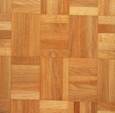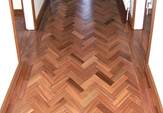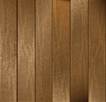Styles of Wooden Flooring
There are three styles of wood floors available on the market today: strip, plank, and parquet. Each style is available in a variety of species, colors and widths, so choosing the right style simply is a matter of which look you prefer.
Parquet Flooring


Parquet flooring comes in size 35 x 10 x 140 M.M, and usually generates a geometric, non-linear look. Parquet flooring can be very simple in design, or somewhat complex. Parquet is a geometric mosaic of wood pieces used for decorative effect. The parquet floor is made from many pieces of wood fitted together like a mosaic or puzzle with varying grains, to create a unique and eye-catching pattern.
The patterns of parquet flooring are entirely geometrical and are visible as angular squares, triangles, lozenges. The most popular parquet flooring pattern is Herringbone, Basket Weave, Brick & Standard Pattern
Strip Flooring

Strip flooring ranges from 45 X 10 X 225 -300 M.M, and creates a linear effect in a room, often making the room appear larger. Strip flooring generally is considered “traditional” wood flooring.
Wide Planks Flooring

Plank flooring typically ranges from 90-125 x 15 or 20 mm x RL. While plank flooring is linear, like strip flooring, its wider widths often create a more casual look.Each plank has a slot (the groove) cut all along one edge, and a thin, deep ridge (the tongue) on the opposite edge. When installed, the tongue of one board fits snugly into the groove of the adjoining board. The advantage of tongue and groove wood floor is that it fits tightly together producing flush, flat surfaces. The interlocking mechanism restricts excess board movement; resulting in firm, stable flooring. Adding to this stability is a nailing system that is present below the wood surface, integrated to the tongue and groove mechanism. Being below the surface, the nailing system remains invisible, ensuring superior aesthetics
Cross Section of Timbspreads Wooden Flooring Systems















